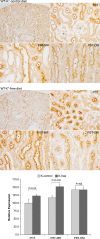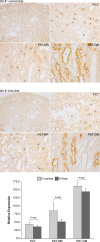Regulation of renal NaDC1 expression and citrate excretion by NBCe1-A
- PMID: 31188034
- PMCID: PMC6732450
- DOI: 10.1152/ajprenal.00015.2019
Regulation of renal NaDC1 expression and citrate excretion by NBCe1-A
Abstract
Citrate is critical for acid-base homeostasis and to prevent calcium nephrolithiasis. Both metabolic acidosis and hypokalemia decrease citrate excretion and increase expression of Na+-dicarboxylate cotransporter 1 (NaDC1; SLC13A2), the primary protein involved in citrate reabsorption. However, the mechanisms transducing extracellular signals and mediating these responses are incompletely understood. The purpose of the present study was to determine the role of the Na+-coupled electrogenic bicarbonate cotransporter (NBCe1) A variant (NBCe1-A) in citrate metabolism under basal conditions and in response to acid loading and hypokalemia. NBCe1-A deletion increased citrate excretion and decreased NaDC1 expression in the proximal convoluted tubules (PCT) and proximal straight tubules (PST) in the medullary ray (PST-MR) but not in the PST in the outer medulla (PST-OM). Acid loading wild-type (WT) mice decreased citrate excretion. NaDC1 expression increased only in the PCT and PST-MR and not in the PST-MR. In NBCe1-A knockout (KO) mice, the acid loading change in citrate excretion was unaffected, changes in PCT NaDC1 expression were blocked, and there was an adaptive increase in PST-MR. Hypokalemia in WT mice decreased citrate excretion; NaDC1 expression increased only in the PCT and PST-MR. NBCe1-A KO blocked both the citrate and NaDC1 changes. We conclude that 1) adaptive changes in NaDC1 expression in response to metabolic acidosis and hypokalemia occur specifically in the PCT and PST-MR, i.e., in cortical proximal tubule segments; 2) NBCe1-A is necessary for normal basal, metabolic acidosis and hypokalemia-stimulated citrate metabolism and does so by regulating NaDC1 expression in cortical proximal tubule segments; and 3) adaptive increases in PST-OM NaDC1 expression occur in NBCe1-A KO mice in response to acid loading that do not occur in WT mice.
Keywords: Na+-dicarboxylate cotransporter 1; citrate; proximal tubule.
Conflict of interest statement
No conflicts of interest, financial or otherwise, are declared by the author(s).
Figures












Similar articles
-
NBCe1-A is required for the renal ammonia and K+ response to hypokalemia.Am J Physiol Renal Physiol. 2020 Feb 1;318(2):F402-F421. doi: 10.1152/ajprenal.00481.2019. Epub 2019 Dec 16. Am J Physiol Renal Physiol. 2020. PMID: 31841393 Free PMC article.
-
Expression of sodium-dependent dicarboxylate transporter 1 (NaDC1/SLC13A2) in normal and neoplastic human kidney.Am J Physiol Renal Physiol. 2017 Mar 1;312(3):F427-F435. doi: 10.1152/ajprenal.00559.2016. Epub 2016 Dec 7. Am J Physiol Renal Physiol. 2017. PMID: 27927654 Free PMC article.
-
Acid-base effects of combined renal deletion of NBCe1-A and NBCe1-B.Am J Physiol Renal Physiol. 2022 Feb 1;322(2):F208-F224. doi: 10.1152/ajprenal.00358.2021. Epub 2022 Jan 10. Am J Physiol Renal Physiol. 2022. PMID: 35001662 Free PMC article.
-
SLC26A6 and NADC‑1: Future direction of nephrolithiasis and calculus‑related hypertension research (Review).Mol Med Rep. 2021 Nov;24(5):745. doi: 10.3892/mmr.2021.12385. Epub 2021 Aug 30. Mol Med Rep. 2021. PMID: 34458928 Review.
-
Sodium-coupled dicarboxylate and citrate transporters from the SLC13 family.Pflugers Arch. 2014 Jan;466(1):119-30. doi: 10.1007/s00424-013-1369-y. Epub 2013 Oct 10. Pflugers Arch. 2014. PMID: 24114175 Review.
Cited by
-
Increasing plasma L-kynurenine impairs mitochondrial oxidative phosphorylation prior to the development of atrophy in murine skeletal muscle: A pilot study.Front Physiol. 2022 Sep 30;13:992413. doi: 10.3389/fphys.2022.992413. eCollection 2022. Front Physiol. 2022. PMID: 36246103 Free PMC article.
-
Exploring the characteristics of gut microbiome in patients of Southern Fujian with hypocitraturia urolithiasis and constructing clinical diagnostic models.Int Urol Nephrol. 2023 Aug;55(8):1917-1929. doi: 10.1007/s11255-023-03662-6. Epub 2023 Jun 9. Int Urol Nephrol. 2023. PMID: 37294502
-
Dietary Sodium and Potassium Intakes and Kidney Stone Prevalence: The National Health and Nutrition Examination Survey 2011-2018.Nutrients. 2024 Jul 10;16(14):2198. doi: 10.3390/nu16142198. Nutrients. 2024. PMID: 39064640 Free PMC article.
-
α-Ketoglutaric acid ameliorates hyperglycemia in diabetes by inhibiting hepatic gluconeogenesis via serpina1e signaling.Sci Adv. 2022 May 6;8(18):eabn2879. doi: 10.1126/sciadv.abn2879. Epub 2022 May 4. Sci Adv. 2022. PMID: 35507647 Free PMC article.
-
Unravelling the Complex Relationship between Diet and Nephrolithiasis: The Role of Nutrigenomics and Nutrigenetics.Nutrients. 2022 Nov 23;14(23):4961. doi: 10.3390/nu14234961. Nutrients. 2022. PMID: 36500991 Free PMC article.
References
-
- Alper SL. Familial renal tubular acidosis. J Nephrol 23, Suppl 16: S57–S76, 2010. - PubMed
Publication types
MeSH terms
Substances
Grants and funding
LinkOut - more resources
Full Text Sources
Molecular Biology Databases
Research Materials

